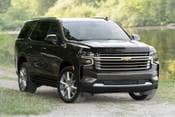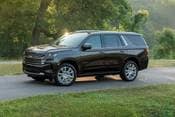2022 Chevy Tahoe Review
Price Range: $41,998 - $63,998
 View 454 more photos
View 454 more photos View 454 more photos
View 454 more photos View 454 more photos
View 454 more photos View 454 more photos
View 454 more photos View 454 more photos
View 454 more photos+450
Average
7.4
out of 10
edmunds TESTED
The redesigned 2022 Tahoe has big improvements in ride comfort, technology and convenience features. But overly firm seats and a puzzling interior layout mean there's less useful storage than you might expect for such a big vehicle. Still, family haulers don't get much more modern and capable than this.
2022 Chevrolet Tahoe Review
by the Edmunds Experts
What's new
- Minor changes to package contents and names throughout lineup
- Lane keeping assist and front and rear parking sensors are now standard
- Enhanced Google-based voice controls for 10.2-inch infotainment system
- Part of the fifth Tahoe generation introduced for 2021
Cost to Drive
Monthly estimates based on costs in Florida
$213/mo for Tahoe Fleet
Tahoe Fleet
vs
$220/mo
Avg. Large SUV
See Edmunds pricing data
Has Your Car's Value Changed?
Used car values are constantly changing. Edmunds lets you track your vehicle's value over time so you can decide when to sell or trade in.

Reliability Ratings by RepairPal
3.5 out of 5 stars3.5/5Above Average
#27 out of 32 among Midsize SUVs
RepairPal Reliability Ratings are based on the actual cost, frequency, and severity of unscheduled repairs and maintenance on make/model data for select 2008-2022 vehicles. The reliability of a specific vehicle may vary depending on its maintenance and driving history, model year, trim, and features.
Cost
$623/yr
vs. $485/yr
for Average Midsize SUV
for Average Midsize SUV
Frequency
1.14x/yr
vs. 1.18x/yr
for Average Midsize SUV
for Average Midsize SUV
Severity
17.4%
vs. 13.5%
for Average Midsize SUV
for Average Midsize SUV
powered by RepairPal
Chevrolet Tahoe Owner Reviews
Most Helpful Owner Reviews
Trending topics
Many Malfunctions with NO resolutions
3 out of 5 starscwilliams00, 01/28/2021
2021 Chevrolet Tahoe LT 4dr SUV 4WD (5.3L 8cyl 10A)
Let me start off by saying I Love Tahoes and have purchased 4 and traded in my 2017 for the newly 2021 model. My truck had been in the shop 8 times to say it took 45 days to get here because it was in quality assurance. I understand the recalls as they come with any vehicles, especially new ones. However, my constant problem has been with the engine light coming on every day, and I … purchased my vehicle in September and still do not have inspection sticker due to this. Secondly, my head rest have been replaced and fixed 3x but every time the seats go down, they break (back seats). My biggest problem, I see where many have complained about the malfunctions within the screen/car play/blue tooth. The screen occasionally goes black, gets stuck and does not work. I have had it to loose sound, to include radio. During calls, the other calls and yourself will sound like a robot, whether or not it is connected by Bluetooth or through the aux plug. Personally, I hold so many conference calls while on the road or driving for my business. Its a big problem when you cant do this hands free. I have never encountered this problem with any of my other tahoes. I have been able to record all of this and have sent it to the shop 8 times, but they can only send a complaint to GM hoping many will complain enough for GM to replace. If not, I am stuck with the problem for no telling how long.
Wait it out
3 out of 5 starsHustleJE, 11/12/2020
2021 Chevrolet Tahoe Premier 4dr SUV (5.3L 8cyl 10A)
Purchased a 2021 Tahoe Premier in early October, it has already been in the shop once and is about to go back in. With this new model, there are several issues and bugs already popping up.
The first issue we had was an improperly installed front bumper sensor that was not seated flush on the bumper. When you pushed it with your finger, it pushed all the way into the bumper. Chevy had to … rip off a bumper from another Tahoe on the lot to install on mine.
This week, we have received two error messages on the dashboard:
- "Service Safety Restraint System"
- "Check Reverse Lamp" when putting vehicle in reverse.
I called our dealer and this is a known issue with the 2021's. We are now working on a gameplan to get these issues, plus 1 other bulletin/recall related to the braking system resolved.
While I love the interior and exterior look of the new Tahoe, I'd wait for these current and future bugs to be resolved. This is by far the worst experience I've had with a brand new car.
2021 Tahoe RST Engine Failure
2 out of 5 starsShae , 03/18/2021
2021 Chevrolet Tahoe RST 4dr SUV (5.3L 8cyl 10A)
We purchased our 2021 Tahoe RST in November. This SUV is babied more than my toddler. We absolutely love everything other than the completely useless Rear Entertainment System. Also, the fact that you are “sold” all of these features such as Navi, two screen rear-entertainment, etc. but then to use the features, it’s an ONStar monthly costs as well to have the word-if, certain packages, … etc. The entertainment does not use Apple Car Play. You pretty much have to use a Firestick, USB of movies, etc. to utilize it. If you don’t turn off the option where your car doesn’t cut off when it’s stopped it will reset the devices at every red light. This feature has to be turned off every time you start the car. So, we opt to use the iPads instead. Total waste of money there. However, we love our Tahoe in spite of those things UNTIL YESTERDAY. We have less than 6400 miles in it. We were going about 30 minutes up the road and 10 minutes into our drive the vehicle started to pop. Then it started to shake. Then it started to miss. It went from our new car feel to a log truck in less than 5 minutes. We finally make it to the dealership and they tell us it’s not driveable. The lifter in Cylinder 4 isn’t working period. The emissions light went off. The traction system went off. Just about every sensor on the truck went crazy. I’m not sure how long it’s going to be in the shop. They put me in an Equinox loaner car which is equally infuriating. It’s very concerning, at best, to be having major engine problems at less than 6500 miles on a $70k vehicle. Stay tuned.
Total LEMON!!!
1 out of 5 starsBarry Burks, Little Rock Arkan, 01/22/2021
2021 Chevrolet Tahoe LS 4dr SUV (5.3L 8cyl 10A)
Bought 2 months ago. Been in shop 1 month. 9 problems after driving off the lot!!!
2021 Tahoe:
1. Brakes recall
2. Key fob not found while driving
3. Right rear door handle cable broken
4. Service Safety Restraint System light on
5. Steering column box replaced
6. Rear power outlet not working
7. Title or vin number incorrect. Shows preowned!!
8. Rear window sensor out
9. Rear wipers … don't work
RIDICULOUS!!!!
We have a limited number of reviews for the 2022 Chevrolet Tahoe, so we've included reviews for other years of the Tahoe since its last redesign.
2022 Chevrolet Tahoe videos
27,000 Miles in Our 2022 Chevy Tahoe Z71 | Long-Term Test Update | Likes, Dislikes & More
It's been just over a year and 27,000 miles since we bought our long-term Chevy Tahoe Z71 — and that means it's time for an update! Join Edmunds' Clint Simone for a rundown of what we've liked, what we haven't, and how our overall ownership experience has been so far.
2022 Tahoe Highlights
Fleet
| Base MSRP Excludes Destination Fee | $48,400 |
|---|---|
| Engine Type | Gas |
| Combined MPG | 17 MPG |
| Cost to Drive | $213/month |
| Seating | 9 seats |
| Cargo Capacity All Seats In Place | 25.5 cu.ft. |
rear wheel drive | |
| Warranty | 3 years / 36,000 miles |
Safety
Our experts like the Tahoe models:
- Forward Collision Alert
- Warns you to take action to avoid colliding with a vehicle or other object in front of the SUV.
- Lane Keep Assist
- Alerts you when the SUV drifts out of its lane and delivers steering input to keep the vehicle in its lane.
- Safety Alert Seat
- Vibrates the driver's seat cushion when the crash avoidance tech detects a situation that may need your attention.
NHTSA Overall Rating
4 out of 5 starsThe National Highway Transportation Safety Administration offers independent analysis.
- Frontal Barrier Crash RatingOverall4 / 5Driver5 / 5Passenger4 / 5
- Side Crash RatingOverall5 / 5
- Side Barrier RatingOverall5 / 5Driver5 / 5Passenger5 / 5
- Combined Side Barrier & Pole RatingsFront Seat5 / 5Back Seat5 / 5
- RolloverRollover3 / 5Dynamic Test ResultNo TipRisk Of Rollover21.2%
People who viewed this also viewed
| Starting at $66,900 |
| 5.0 average Rating out of 2 reviews. |
| Starting at $61,500 |
| 3.5 average Rating out of 6 reviews. |
| Starting at $62,425 |
Related Used 2022 Chevrolet Tahoe info
Vehicle reviews of used models
- Ram 2500 2021 Review
- Toyota Tundra 2020 Review
- BMW I8 2020 Review
- Volkswagen Atlas 2020 Review
- Volkswagen Jetta 2021 Review
Shop similar models
- Used Jeep Grand-cherokee 2025
- Used Jeep Grand-cherokee-wk 2023
- Used Volkswagen Atlas-cross-sport 2025
- Used Volkswagen Touareg 2017
Shop used vehicles in your area
- Used Chevrolet Blazer 2019
- Used Chevrolet Blazer 2020
- Used Chevrolet Blazer 2021
- Used Chevrolet Blazer 2023
- Used Chevrolet Trailblazer 2021
- Used Chevrolet Trailblazer 2023
Popular new car reviews and ratings
- Kia Sportage 2026
- 2025 Hyundai Tucson
- Ford Mustang 2025
- Honda Accord 2025
- 2025 Q5
- Toyota Venza 2024
- 2025 Kia K4
- 2026 Kia K4 News
- 2025 Mercedes-Benz GLE-Class
- New Genesis G80
Research other models of Chevrolet
- New Chevrolet Corvette Stingray
- 2025 Silverado 3500HD
- New Chevrolet Suburban
- Chevrolet Express Cargo 2024
- 2025 Chevrolet Corvette Stingray
- Chevrolet Express 2024
- 2024 Chevrolet Malibu
- New Chevrolet Silverado 1500
- 2025 Chevrolet Blazer EV
- 2024 Chevrolet Blazer
Research similar vehicles
Other models
- Used Honda Prelude in Escondido, CA 2001
- Used Ferrari California in Tacoma, WA 2014
- New BMW M5 for Sale in Bluefield, WV
- New Toyota Gr-Supra for Sale in Culver City, CA
- Used Porsche 718-Boxster in Keene, NH 2025
- Used Porsche 911 in New Rochelle, NY 2025
- New Kia Ev6 for Sale in Alvin, TX
- Used BMW Alpina-B8-Gran-Coupe in Rialto, CA 2025
- Used BMW M4-CS in Cocoa, FL 2025
- Used Kia Amanti in Orange, CA 2009
